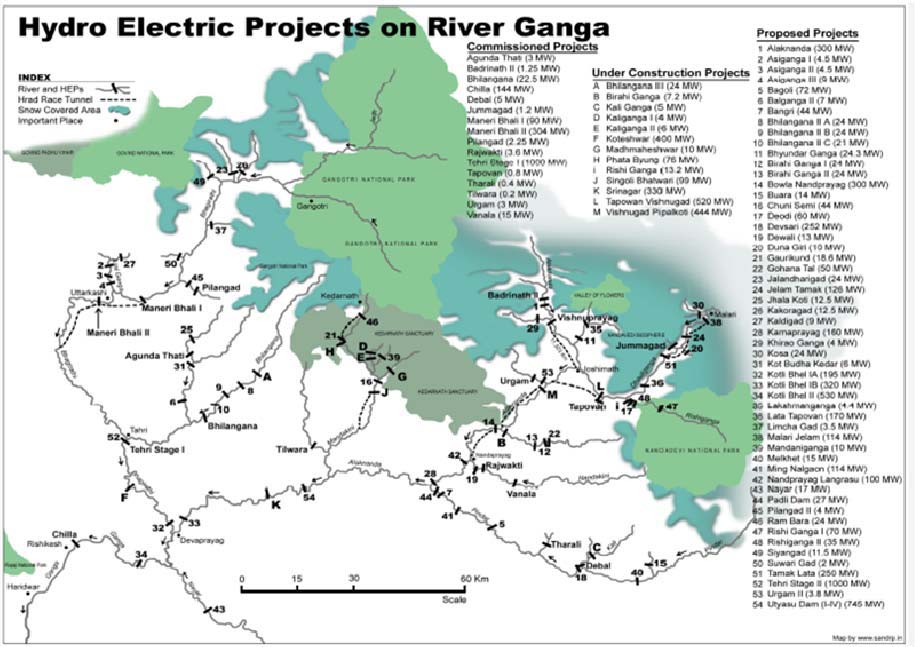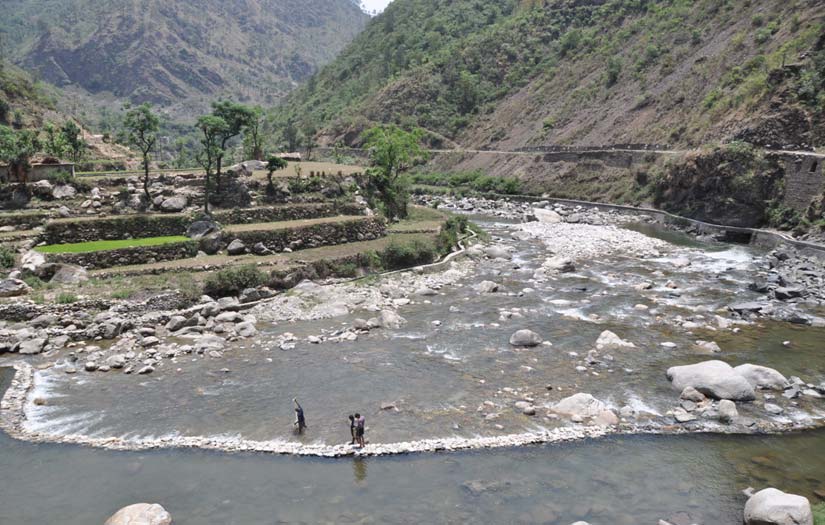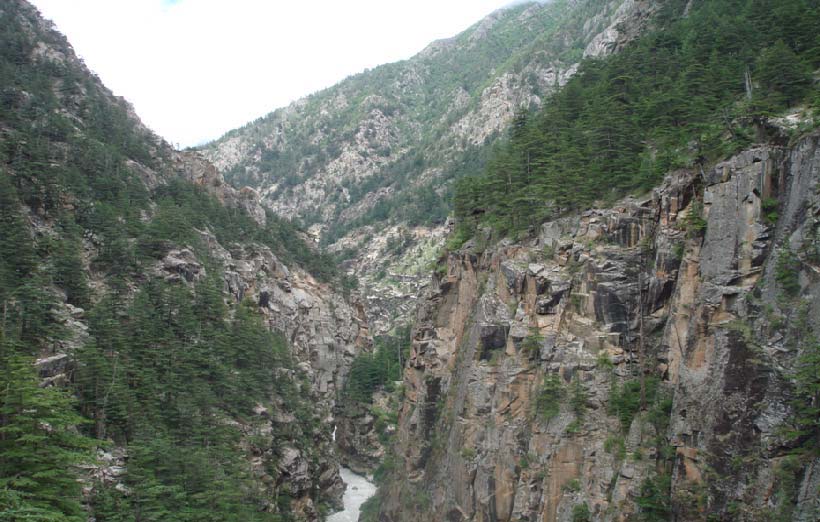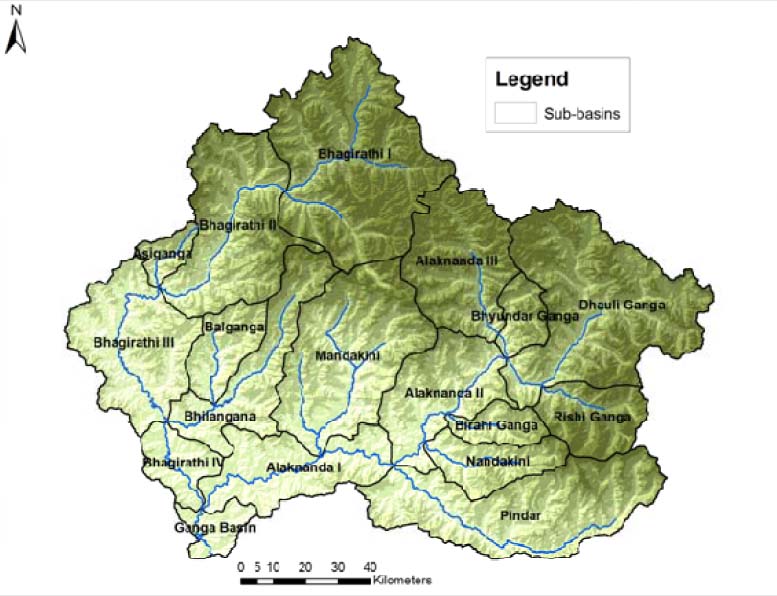Guest post: Amita Bhaduri
Images courtesy: Wildlife Institute of India
Expressing doubts at the major plans to expand hydropower generating capacity in Uttarakhand, a report commissioned by the Ministry of Environment and Forests has recommended that the twenty four dams planned on the Alaknanda and Bhagirathi rivers, the two main tributaries of the Ganga in Uttarakhand should not be allowed, as they will cause irretrievable harm to the river.

Hydroelectric projects on the river Ganga
Image courtesy: www.sandrp.in
This report by the Wildlife Institute of India (WII), commissioned by the Ministry of Environment and Forests has studied the cumulative environmental and ecological impacts of hydroelectric projects in the Ganga basin on the riverine ecosystem including on terrestrial and aquatic biodiversity and has expressed fears over the feasibility of the projects.
Hydropower development in Uttarakhand
Uttarakhand is estimated to have a hydropower potential to the tune of 20236 MW against which around 1851 MW has been harnessed thus far through hydroelectric projects. The State with mighty rivers like Ganga, Yamuna, Kosi etc., is an ideal location for hydropower development owing to high heads and yields and projects like Tehri have come up as a result.
A World Bank report (2011) has highlighted that hydropower potential is one of the most important strategic assets of the State for the development of its economy. Thus, projects of varying capacities are being implemented by State and Central Government agencies and as well as the private sector in the State.
Many of these projects have run into troubled waters and some have been halted or shelved amid intensified public protests. The State government and bureaucrats have alternatively sought to step up efforts to seek revival of the projects in order to ‘boost the dismal power situation in the State’.
The tussle between the State and the anti-dam demonstrators who are opposing the projects on religious (the Ganges river system is considered holy by the Hindus), social justice and environmental grounds escalates from time to time.
Intense public outcry and the "fast-unto-death" by eminent scientist Prof. G D Agarwal in protest against the 600 MW Loharinag Pala hydropower project in Uttarakhand had in September 2010 led the Finance Minister, who was heading a Group of Ministers looking into the issue, to announce the complete scrapping of the project.
Later, that year in November 2010 the Central Government decided at the National Ganga River Basin Authority meeting to halt work on the National Thermal Power Corporation (NTPC) owned 600 MW Lohari Nagpala and the State Government owned 480 MW Pala Maneri & 350 MW Bharav Ghatti projects. Further, owing to mounting environmental concerns, the 440 MW Vishnusagar project had to be scrapped.
The Government in addition notified the river stretch of 135 kilometres of Alaknanda-Bhagirathi as an ecologically sensitive area, and hence a dam free zone through which the river will flow freely. These are a partial admission that the process and plans of installing hydroelectric projects had been wide off the mark.
It does not however look like something is being done on a long term basis, to ameliorate the situation which the public is complaining about. For instance, after one year of stoppage of the Lohari Nagpala project, work was resumed. Prof. G D Agarwal has in the meanwhile this year carried out a "fast-unto-death" in protest against this project located on the Bhagirathi river.
Disenchanting report by IIT-Roorkee
Earlier in June 2011, a study carried out by the Alternate Hydro Energy Centre (AHEC) of IIT-Roorkee for MoEF had assessed the cumulative impact of seventy hydro-power projects commissioned or in various stages of development on these rivers. 54 of these were run of the river while the rest were storage projects.
This report was to estimate the extent to which hydropower potential identified in the basins should be developed without risking stability of landforms and environment. The report came as a big disappointment and restrictions were not placed in the development of hydropower in the two basins, and instead more hydroelectric projects were advocated.
While both Alaknanda and Bhagirathi rivers have their origin in glaciers, the report suggests that glaciers are in much higher altitudes, upstream and too distant to be affected by the hydropower projects. The study does not take into consideration the fact that Himalayan glaciers are retreating at a fast pace and that less water would be available in the rivers negatively impacting the hydropower projects.

Balganga sub-basin
The report calculates that the existing hydropower projects would affect 47.3 per cent of Bhagirathi and its tributaries and 43.9 per cent of Alaknanda and its tributaries. But it does not assess what the cumulative impact of such changes would be on the rivers and their tributaries.
On the contrary it advocates fixing a threshold at seventy per cent wherein a river and its tributaries may be allowed to be affected by way of submergence and diversion up to seventy per cent of its length. While the report admits that over seventy per cent of Bhagirathi river was getting affected due to Loharinag Pala project, it sought the revival of the projects instead of a moratorium on them.
The study recognizes that hydropower projects restrict the flow of rivers and that a certain quantity of water should “always flow in the rivers”. It describes this flow as “environmental flow” but bases its calculations on the “minimum flow” required, ignoring needs and expectations of people living on the banks, and flows required to help the flora and fauna to prosper and flourish.
The report acknowledges that the minimum flow may reduce power generation. It states that the reduction may make several schemes unviable especially small-scale hydropower schemes. The study however does not talk of scrapping the projects to prevent this.
Himanshu Thakkar of the South Asian Network on Dams, Rivers and People, states that “the report has not done cumulative impact assessment, has shown bias in favour of hydropower projects and that its recommendations and conclusions are unfounded. It has not looked at the poor quality of EIAs-EMPs done for these projects and almost universal non-compliance of environment norms in the implementation of these projects. In short, the shoddy report is a lost opportunity and needs to be rejected, even while following up on some of the half hearted recommendations.” [Ganga hydel impact assessment report biased, Prasanna Mohanty, www.GovernanceNow.com, 2011]

Bhagirathi river
Wildlife Institute of India report cautions about the threat to biodiversity
Wildlife Institute of India had been approached by the Ministry of Environment and Forests to conduct a study on the cumulative environmental/ecological impacts of hydroelectric projects in the Bhagirathi and Alaknanda river basins on the riverine ecosystem, including on terrestrial and aquatic biodiversity. This assessment takes into account the cumulative impact of 70 hydroelectric projects in the Alakananda and Bhagirathi basins of which 17 are existing (1851 MW), 14 are under-construction (2538 MW) and 39 are proposed (4644 MW).
The study aimed to assess the baseline status of rare, endangered and threatened (RET) species of flora and fauna dependent on riverine habitats and flood-plains of Alaknanda and Bhagirathi river basins.

Sub-basins within Alaknanda and Bhagirathi
Critically important habitats along the existing and planned hydropower projects located on rivers Alaknanda and Bhagirathi up to Devaprayag were to be identified. The study delineated river stretches critical for conservation of rare, endangered and threatened (RET) aquatic species. It also attempted to assess the key habitat variables for RET species, including minimum flows and volume of water for ecological sustainability of the two rivers.
The study warns that the Uttarakhand hydropower projects threaten the biodiversity of Ganga. The study was released just before the meeting of the National Ganga River Basin Authority in April, 2012 which side tracked the issue of hydel projects, and expresses concern over the planned hydroelectric projects, that add up to a capacity of 2,600 MW in Uttarakhand.
As regards impact on aquatic biodiversity and their habitats, the study says that if all the proposed hydropower projects are implemented, of the 1121 km long stretch of the rivers that flow in the entire Alaknanda-Bhagirathi basins, atleast 47 per cent of the total stretch of the rivers in the entire basin, will be affected.

Critical habitats on Alaknanda-Bhagirathi sub-basins
Therefore, significant area of the fish habitat would either be modified or lost due to th eproposed hydropower projects in the basin. Out of 76 species of fish reported in the entire basin, a total of 66 species have been reported in the influence zones of hydropower projects. This means that about 87 per cent of fish species would be affected, if all proposed hydropower projects get implemented in the basin.
Among 18 sub-basins in the region, the most affected sub-basins with respect to fish habitat modification/loss would be Bhagirathi III and IV (71 per cent), Birahi Ganga (74 per cent), Alaknanda I & II (48 per cent), Mandakini (44 per cent), Balganga (40 per cent) and Nandakini (35 per cent). Although, fish was not found in Dhauliganga, nearly 94 per cent of stretch of this river would be affected which in turn would adversely impact the downstream fish species, in the main Alaknanda river.
The report states that dams or any construction across rivers is always detrimental to the survival of fishes especially of migrants, which use different habitats for completing life history requirements. There are a minimum of 17 species of migrant fishes found in the Alaknanda and Bhagirathi basins, which include three species of Mahseer that are long distance migrants.
Any obstacle such as a dam or a barrage across a river will hamper normal migratory behaviour of these fishes and consequently affect their breeding cycle. Their migration has already been obstructed by Tehri dam. Based on literature and observations made in various studies, it is confirmed that there has been a general decline in the populations of Mahseer in the upstream of Bhagirathi river due to the barrier effect caused by the Tehri dam. The report notes that the efficiency of fish pass in the Himalayan rivers would be highly reduced, if the dam height is more than 16 m.
Changes in the sedimentation flows due to dam/barrier construction especially in Himalayan rivers will also have an adverse impact on fish habitats. It is expected that submersible zones of hydropower projects would be unsuitable for several fishes especially Snow Trout and Himalayan Loaches. Therefore, the hydropower projects with longer stretches of submersible zones but without proper silt removal plans would be detrimental to populations of several Himalayan fish species. Adverse impacts on the aquatic biodiversity are expected because of changes in the natural flow due to hydropower projects in the Alaknanda and Bhagirathi basin.
15 of these hydropower projects would stop the nutrient flow either for longer period or for a shorter period, depending upon the presence of a dam or barrage. A minimum 162.6 km long stretch of the rivers, in the entire basin would be submerged due to various hydropower projects. These submerged rivers would act as nutrient traps. Therefore, changes in the nutrient flow due to hydropower projects would affect the overall composition of the fish community in the Alaknanda and Bhagirathi basins.
On the biodiversity profile and critical habitats, the report notes that over 35 mammals, 350 birds and 1000 plants have been reported in these sub-basins. Of these, five each of mammals and birds, and 55 plant species are rare, endangered or threatened. Bhagirathi-I, Mandakini, Alaknanda-III, Dhauli ganga, Rishi and Bhyundar ganga subbasins have very high terrestrial biodiversity values.
Species such as the Snow Leopard, Brown Bear, Musk Deer, Cheer Pheasant and three species of vultures are found in these sub-basins. Snow Leopard is extremely rare and occurs only in Bhagirathi-I, Mandakini, Alaknanda -III, Bhyundar, Dhauliganga, Rishi Ganga, Pindar,and Nandakini sub-basins.
The forest types of the Alaknanda basin range from the Himalayan subtropical scrub at lower elevations, temperate broad leaved forests in the middle elevations to sub-alpine oak and conifer forests at ‘tree line’ at the higher elevations whereas that of Bhagirathi basin ranges from the Himalayan subtropical scrub at lower elevations to sub-alpine birch-rhododendron forests at ‘tree line’.
The two basins support over 300 medicinal plants within which the highest number (over 150) occur in Alaknanda I sub-basin. The Alaknanda and Bhagirathi sub-basins also harbour certain plant species which are endemic to Uttarakhand.
The minimum environmental flows that have been suggested need to be reviewed periodically in relation with changes in the population status of fish. This review may be carried out once in every five years with inputs from professional institutions such as National Institute of Hydrology, IIT Roorkee, National Bureau of Fish Genetic Resources, Directorate of Cold Water Fisheries Research, local universities etc.
The implementation of the current hydropower power plan which envisages the operation of 70 hydropower projects is likely to significantly impact the aquatic biodiversity of Bhagirathi IV and Ganga sub-basins and the report calls for review of the 24 proposed projects.
Conclusion
In the final analysis, the combined footprint of all 24 projects have been considered for their potential to impact areas with biodiversity values (both aquatic and terrestrial), critically important habitats for RET and IWPA protected species in different sub-basins in the two larger landscape units, the Alaknanda and Bhagirathi basins. Some of these sub-basins harbour areas of Outstanding Universal Values.
Power generation companies like NHPC, NTPC, Lanco, GMR Energy, GVK and JP Power were setting up projects in Uttarakhand. According to a report in the Business Standard, “over Rs 17,000 crore worth of investments in Uttarakhand would be impacted if the Government stops work on various hydel projects in the state.”
The big projects that are going to be affected are the 530 MW Kotlibhel II, the 250 MW Tamak Lata on Dhauli Ganga, the 320 MW Kotlibhel IB on Alaknanda, the 381 MW Bharon Ghati and the195 MW Kotlibhel IA on Bhagirathi.
The WII report concludes by stating that “ecological prudence therefore requires that securing long term biodiversity conservation should get precedence over economic considerations visualized in commissioning these 24 projects.”
An article in IBNLive [300 dams on the Ganga: A bane or a boon? Bahar Dutt, 2012] claims that the Government has planned over 300 dams on its various tributaries to generate electricity and the move comes despite the Government-commissioned green panel report (by Wildlife Institute of India) that has recommended scrapping many of the dams citing environmental concerns.
The question remains as to whether the government has taken note of the study and as to when will it rechannel its efforts to protect and regenerate the health of the two river systems.
/articles/twenty-four-hydro-electric-power-projects-ganga-uttarakhand-need-be-assessed-prevent